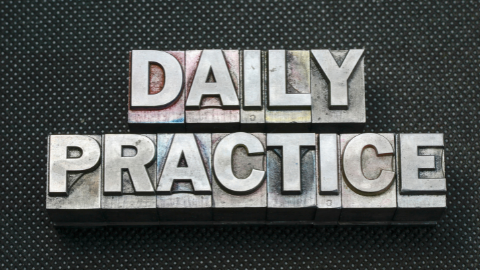Sedentary lifestyles inevitably result in thousands of hours spent with your body resembling a human question mark, your head jutting forward, rounded shoulders, and your stomach getting closer to your knees.
Crick in the Neck
Neck and shoulder pain from sitting at computer workstations is far too common.
A frequent neck pain complaint is a crick in the neck or stiff neck. It can develop from numerous things, like awkward positions, lifting something overhead with poor form or that’s too heavy, looking down at your phone, excessive texting, or even from long hours of typing with a turtleneck posture.

Sound familiar?
Well, whenever you overstretch and strain your neck muscles, the resulting pain and limited mobility can last for just a day or two, or even for several weeks. Not fun, right?
Suppose you start to experience other symptoms, like shooting pain into your shoulder, arm, or hands, numbness, tingling, or weakness in the arm.
In that case, it’s always best to see your doctor to rule out a nerve compression or other neurological condition.
Get Rid of Neck and Shoulder Pain From Sitting At Computer
The following 11 moves will help give you fast relief if you’re experiencing neck and shoulder pain from sitting at a computer all day.
Move #1: Suboccipital Release
Forward head postures can cause a chronic shortening of the suboccipitals.
These are the tiny muscles at the base of your skull, whose primary function is to rock and tilt your head into extension.
Tightness in the suboccipitals can lead to a stiff neck and headaches.
To do the suboccipital release, you place your hands on the back of your head with your thumbs resting on the base of your neck, and then slowly extend your neck backward into your thumbs and apply static pressure for about eight to 12 seconds.
Move your thumbs a little closer together, and repeat the static pressure.
Move #2: Rake & Twist
Turn your head to the left and place your right hand on the back of your neck.
Rake or drag your fingers across the back of your neck while you turn your head to the right.
Repeat the rake and twist move three times, slowly moving your hand down the back of your neck.
Then, repeat on the right side of your neck.
Move #3: SCM Massage
The sternocleidomastoid, or SCM for short, is one of the largest and most superficial neck muscles that helps you rotate your head and flex your neck.
When a person assumes a forward head posture, the SCM flexes and shortens. Over time, this adaptive shortening can cause trigger points to form, leading to pain in the head’s forehead, sinus, ear, and back.
To massage the SCM, you want to turn your head away from the painful side and then grasp the SCM between your thumb and index finger for about eight to 12 seconds.
Slowly move up to the middle of the SCM, grasp it, and then hold for another eight to 12 seconds.
Then continue the SCM massage until you reach the highest point, near the jawline. Then, repeat the entire process on the opposite side of your neck.
Move #4: Scalenes Pin & Stretch
The scalene muscles help you inhale, flex your head forward, and rotate side to side.
When the scalene muscles get tight, they can entrap the nerves that pass under them, resulting in numbness, pain, and tingling down the arm into the fingers.
To do the scalenes pin and stretch technique, you first hook your fingertips down onto the scalenes, right in the middle portion of your clavicle bone, that’s the collarbone.
Then turn your head toward the fingers to shorten the scalenes, pinning them down with your fingertips. Take a deep breath and inhale, and as you exhale, turn your head away to stretch the scalenes.
Repeat this pin and stretch technique until you reach the end of the clavicle. Then, do the same thing on the opposite side.
Move #5: Trigger Point Bar
I fastened a tennis ball to the end of a Back Knobber 2 trigger point bar to widen the surface area that I’m going to massage.
Place it right where you feel the knot in your shoulder blade or upper traps, and then anchor the bar down into that knock for about eight to 12 seconds.
As you press down on the tight spot, rotate your head away to stretch it. Continue working the area until you feel the knot release and soften.
Move #6: Chin Tuck
Chin tucks help to strengthen your neck muscles, so your neck posture looks more neutral and aligned.
When looking straight ahead, place two fingers on your chin, and then bring your head straight back. Hold for about three to five seconds, and then release.
Repeat this ten times.
Move #7: Neck Extension with Rotation
Start in a chin tuck position, then raise your chin and tilt your head backward.
While your head is tilted back, slowly rotate your head side to side. Hold the stretch for about two seconds, and then repeat ten times.
Move #8: Neck Lateral Flexion
Look straight ahead and begin with a chin tuck exercise. Grip your right hand over your head, and then move your right ear towards your right shoulder as you anchor your left hand down towards the floor. Hold the stretch for a few seconds, and repeat ten times. Do the same thing on the opposite side.
Move #9: Wall Angels
Maintain a neutral spine with your ears in line with your shoulders. Squeeze your shoulder blades together, forming the letter W with your arms. Hold for three seconds.
Now, raise your arms to create the letter Y. Repeat 10 times, do two to three sets.
Move #10: Bent-Over L
The bent-over L exercise strengthens your shoulders and upper back muscles. Begin by bending over at the waist, with your hips, back, and knees slightly bent.
While maintaining a flat back and raised chest, lift your elbows toward the sky as you bend them to 90 degrees. When your elbows reach shoulder height, rotate your forearms upward until the backs of your hands are facing the sky. Reverse this pattern back to the starting point, and repeat ten times. Do three sets.
Move #11: W-Y-T exercise
The W-Y-T exercise is similar to the wall angels but in the prone position.
Start by lying on your stomach, slowly lift your arms off the floor, squeeze your shoulder blades together to form a W.
Hold it there for a few seconds, then move it into a Y, with your palms facing each other. Repeat this ten times, 10 Ws and 10 Ys, and then move into a T position with your palms facing forward and thumbs up.
Repeat this ten times.
Final Thoughts

There you have it, 11 moves that cure neck pain fast.
Now, I can’t promise you that your pain will instantly disappear after going through this entire sequence only one time.
It will be best to practice these moves daily until you experience improved neck posture and pain-free movement.
So promise me that you won’t give up because that stiff neck will become a distant memory before you know it?
